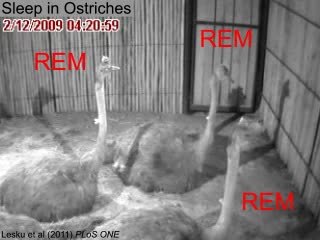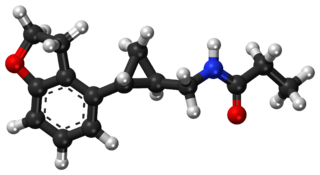Related Research Articles

Fatal insomnia is an extremely rare neurodegenerative prion disease that results in trouble sleeping as its hallmark symptom. The majority of cases are familial, stemming from a mutation in the PRNP gene, with the remainder of cases occurring sporadically. The problems with sleeping typically start out gradually and worsen over time. Eventually, the patient will succumb to total insomnia, most often leading to other symptoms such as speech problems, coordination problems, and dementia. It results in death within a few months to a few years, and there is no known disease-modifying treatment.

A sleep disorder, or somnipathy, is a medical disorder of an individual's sleep patterns. Some sleep disorders are severe enough to interfere with normal physical, mental, social and emotional functioning. Sleep disorders are frequent and can have serious consequences on patients' health and quality of life. Polysomnography and actigraphy are tests commonly ordered for diagnosing sleep disorders.

Insomnia, also known as sleeplessness, is a sleep disorder where people have trouble sleeping. They may have difficulty falling asleep, or staying asleep for as long as desired. Insomnia is typically followed by daytime sleepiness, low energy, irritability, and a depressed mood. It may result in an increased risk of accidents of all kinds as well as problems focusing and learning. Insomnia can be short term, lasting for days or weeks, or long term, lasting more than a month. The concept of the word insomnia has two possibilities: insomnia disorder (ID) and insomnia symptoms, and many abstracts of randomized controlled trials and systematic reviews often underreport on which of these two possibilities the word insomnia refers to.
Somnolence is a state of strong desire for sleep, or sleeping for unusually long periods. It has distinct meanings and causes. It can refer to the usual state preceding falling asleep, the condition of being in a drowsy state due to circadian rhythm disorders, or a symptom of other health problems. It can be accompanied by lethargy, weakness and lack of mental agility.
Hypersomnia is a neurological disorder of excessive time spent sleeping or excessive sleepiness. It can have many possible causes and can cause distress and problems with functioning. In the fifth edition of the Diagnostic and Statistical Manual of Mental Disorders (DSM-5), hypersomnolence, of which there are several subtypes, appears under sleep-wake disorders.

Sleep hygiene is a behavioral and environmental practice developed in the late 1970s as a method to help people with mild to moderate insomnia. Clinicians assess the sleep hygiene of people with insomnia and other conditions, such as depression, and offer recommendations based on the assessment. Sleep hygiene recommendations include: establishing a regular sleep schedule, using naps with care, not exercising physically too close to bedtime, limiting worry, limiting exposure to light in the hours before sleep, getting out of bed if sleep does not come, not using bed for anything but sleep and sex, avoiding alcohol in the hours before bedtime, and having a peaceful, comfortable and dark sleep environment.

Doxylamine is an antihistamine medication used to treat insomnia and allergies, and—in combination with pyridoxine (vitamin B6)—to treat morning sickness in pregnant women. It is available over-the-counter and is typically sold under such brand names as Equate, Unisom, or ZzzQuil, among others; and it is used in nighttime cold medicines (e.g., NyQuil) and pain medications containing acetaminophen and/or codeine to help with sleep. The medication is delivered chemically by the salt doxylamine succinate and is taken by mouth. Doxylamine and other first-generation antihistamines are the most widely used sleep medications in the world.Typical side effects of doxylamine (at recommended doses) include dizziness, drowsiness, grogginess, and dry mouth, among others.

Zaleplon, sold under the brand name Sonata among others, is a sedative and hypnotic which is used to treat insomnia. It is a nonbenzodiazepine or Z-drug of the pyrazolopyrimidine class. It was developed by King Pharmaceuticals and approved for medical use in the United States in 1999.

Trazodone, sold under many brand names, is an antidepressant medication, used to treat major depressive disorder, anxiety disorders, and insomnia. It is a phenylpiperazine compound of the serotonin antagonist and reuptake inhibitor (SARI) class. The medication is taken orally.

Estazolam, sold under the brand name Prosom among others, is a tranquilizer medication of the triazolobenzodiazepine (TBZD) class, which are benzodiazepines (BZDs) fused with a triazole ring. It possesses anxiolytic, anticonvulsant, hypnotic, sedative and skeletal muscle relaxant properties. Estazolam is an intermediate-acting oral benzodiazepine. It is used for short-term treatment of insomnia.

Slow-wave sleep (SWS), often referred to as deep sleep, is the third stage of non-rapid eye movement sleep (NREM), where electroencephalography activity is characterised by slow delta waves.

Lormetazepam, sold under the brand name Noctamid among others, is a drug which is a short to intermediate acting 3-hydroxy benzodiazepine derivative and temazepam analogue. It possesses hypnotic, anxiolytic, anticonvulsant, sedative, and skeletal muscle relaxant properties.
The Epworth Sleepiness Scale (ESS) is a scale intended to measure daytime sleepiness that is measured by use of a very short questionnaire. This can be helpful in diagnosing sleep disorders. It was introduced in 1991 by Dr Murray Johns of Epworth Hospital in Melbourne, Australia.
Shift work sleep disorder (SWSD) is a circadian rhythm sleep disorder characterized by insomnia, excessive sleepiness, or both affecting people whose work hours overlap with the typical sleep period. Insomnia can be the difficulty to fall asleep or to wake up before the individual has slept enough. About 20% of the working population participates in shift work. SWSD commonly goes undiagnosed, so it's estimated that 10–40% of shift workers have SWSD. The excessive sleepiness appears when the individual has to be productive, awake and alert. Both symptoms are predominant in SWSD. There are numerous shift work schedules, and they may be permanent, intermittent, or rotating; consequently, the manifestations of SWSD are quite variable. Most people with different schedules than the ordinary one might have these symptoms but the difference is that SWSD is continual, long-term, and starts to interfere with the individual's life.
5-HTTLPR is a degenerate repeat polymorphic region in SLC6A4, the gene that codes for the serotonin transporter. Since the polymorphism was identified in the middle of the 1990s, it has been extensively investigated, e.g., in connection with neuropsychiatric disorders. A 2006 scientific article stated that "over 300 behavioral, psychiatric, pharmacogenetic and other medical genetics papers" had analyzed the polymorphism. While often discussed as an example of gene-environment interaction, this contention is contested.

Sleep deprivation, also known as sleep insufficiency or sleeplessness, is the condition of not having adequate duration and/or quality of sleep to support decent alertness, performance, and health. It can be either chronic or acute and may vary widely in severity. All known animals sleep or exhibit some form of sleep behavior, and the importance of sleep is self-evident for humans, as nearly a third of a person's life is spent sleeping.

Tasimelteon, sold under the brand name Hetlioz, is a medication approved by the U.S. Food and Drug Administration (FDA) in January 2014, for the treatment of non-24-hour sleep–wake disorder. In June 2014, the European Medicines Agency (EMA) accepted an EU filing application for tasimelteon and in July 2015, the drug was approved in the European Union for the treatment of non-24-hour sleep-wake rhythm disorder in totally blind adults, but not in the case of non-24 in sighted people.

Suvorexant, sold under the brand name Belsomra, is an orexin antagonist medication which is used in the treatment of insomnia. It is indicated specifically for the treatment of insomnia characterized by difficulties with sleep onset and/or maintenance in adults. Suvorexant helps with falling asleep faster, sleeping longer, being awake less in the middle of the night, and having better quality of sleep. Its effectiveness is modest, and is similar to that of other orexin antagonists, but is lower than that of benzodiazepines and Z-drugs. Suvorexant is taken by mouth.
Sleep disorder is a common repercussion of traumatic brain injury (TBI). It occurs in 30%-70% of patients with TBI. TBI can be distinguished into two categories, primary and secondary damage. Primary damage includes injuries of white matter, focal contusion, cerebral edema and hematomas, mostly occurring at the moment of the trauma. Secondary damage involves the damage of neurotransmitter release, inflammatory responses, mitochondrial dysfunctions and gene activation, occurring minutes to days following the trauma. Patients with sleeping disorders following TBI specifically develop insomnia, sleep apnea, narcolepsy, periodic limb movement disorder and hypersomnia. Furthermore, circadian sleep-wake disorders can occur after TBI.
Sleep problems are found to be correlated with poor well-being and low quality of life. Persistent sleeping disturbances can lead to fatigue, irritability, and various health issues. Numerous studies have examined the positive impact of music on sleep quality. As early as 2000 B.C., lullabies were designed to aid infant sleep. For adults with sleep-related disorders, music serves as a useful intervention in reducing stress. Approximately 25% of the population facing sleep difficulties regularly use music as a tool for relaxation. This process can be either self-prescribed or under the guidance of a music therapist.
References
- ↑ Drake, CL; Jefferson, C; Roehrs, T; Roth, T (2006). "Stress-related sleep disturbance and polysomnographic response to caffeine". Sleep Med. 7: 567–72. doi:10.1016/j.sleep.2006.03.019. PMC 2535762 . PMID 16996309.
- ↑ Drake, CL; Scofield, H; Roth, T (2008). "Vulnerability to Insomnia: The Role of Familial Aggregation". Sleep Med. 9: 297–302. doi:10.1016/j.sleep.2007.04.012. PMC 2358982 . PMID 17825612.